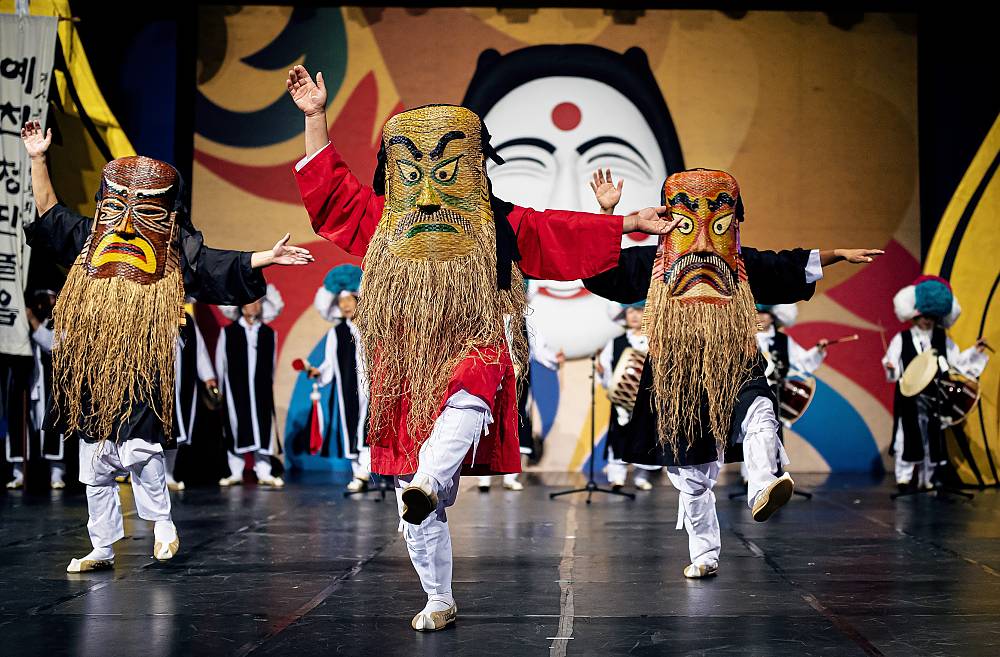5 December 2022
During this year’s session in Rabat, Kingdom of Morocco, the Intergovernmental Committee for the Safeguarding of the Intangible Cultural Heritage inscribed 4 elements on the List of Intangible Cultural Heritage in Need of Urgent Safeguarding, and 39 elements on the Representative List of the Intangible Cultural Heritage of Humanity.
Members of the Committee, chaired by H.E. Mr Samir Addahre, Ambassador and Permanent Delegate of the Kingdom of Morocco to UNESCO, allotted a total of 305,144 USD as part of the International Assistance mechanism to one project to further safeguard living heritage in Malawi titled ‘Safeguarding of ludodiversity in Malawi through formal and non-formal education’.
The Committee also selected 4 programmes for the Register of Good Safeguarding Practices, including ‘Al Sadu Educational Programme: Train the trainers in the art of weaving’ in Kuwait and the ‘Portuguese-Galician border ICH: a safeguarding model created by Ponte…nas ondas!’ in Portugal and Spain.
UNESCO’s Intangible Cultural Heritage Lists now feature 678 elements corresponding to 140 countries.
Additions to List of the Intangible Cultural Heritage in Need of Urgent Safeguarding
— Viet Nam: Art of pottery-making of Chăm people;
— Chile: Quinchamalí and Santa Cruz de Cuca pottery;
— Türkiye: Traditional Ahlat stonework;
— Albania: Xhubleta, skills, craftsmanship and forms of usage.
Additions to the Representative List of the Intangible Cultural Heritage of Humanity
— United Arab Emirates: Al Talli, traditional embroidery skills in the United Arab Emirates;
— Oman: Al-Khanjar, craft skills and social practices;
— Jordan: AAl-Mansaf in Jordan, a festive banquet and its social and cultural meanings;
— Saudi Arabia, Oman and United Arab Emirates: Alheda’a, oral traditions of calling camel flocks;
— Colombia: Ancestral system of knowledge of the four indigenous peoples, Arhuaco, Kankuamo, Kogui and Wiwa of the Sierra Nevada de Santa Marta;
— France: Artisanal know-how and culture of baguette bread;
— Greece: August 15th (Dekapentavgoustos) festivities in two Highland Communities of Northern Greece: Tranos Choros (Grand Dance) in Vlasti and Syrrako Festival;
— Andorra and France: Bear festivities in the Pyrenees;
— Slovenia: Beekeeping in Slovenia, a way of life;
— Iran (Islamic Republic of) and Syrian Arab Republic: Crafting and playing the Oud;
— Azerbaijan and Türkiye: Culture of Çay (tea), a symbol of identity, hospitality and social interaction;
— United Arab Emirates, Bahrain, Egypt, Iraq, Jordan, Kuwait, Mauritania, Morocco, Oman, Palestine, Qatar, Saudi Arabia, Sudan, Tunisia and Yemen: Date palm, knowledge, skills, traditions and practices (the inscription of this element have been extended to countries in bold);
— Egypt: Festivals related to the Journey of the Holy family in Egypt;
— Croatia: Festivity of Saint Tryphon and the Kolo (chain dance) of Saint Tryphon, traditions of Croats from Boka Kotorska (Bay of Kotor) who live in the Republic of Croatia;
— Japan: Furyu-odori, ritual dances imbued with people’s hopes and prayers;
— Tunisia: Harissa, knowledge, skills and culinary and social practices;
— Guatemala: Holy Week in Guatemala;
— Hungary: Hungarian string band tradition;
— Zambia: Kalela dance;
— Saudi Arabia: Knowledge and practices related to cultivating Khawlani coffee beans;
— Cuba: Knowledge of the light rum masters;
— Cambodia: Kun Lbokator, traditional martial arts in Cambodia;
— Austria, Bosnia and Herzegovina, Croatia, Hungary, Italy, Romania, Slovakia and Slovenia: Lipizzan horse breeding traditions;
— Spain: Manual bell ringing;
— Kazakhstan: Orteke, traditional performing art in Kazakhstan: dance, puppet and music;
— Azerbaijan: Pehlevanliq culture: traditional zorkhana games, sports and wrestling;
— Democratic People’s Republic of Korea: Pyongyang Raengmyon custom;
— Algeria: Raï, popular folk song of Algeria;
— Afghanistan, Azerbaijan, Iran (Islamic Republic of), Türkiye, Tajikistan, Turkmenistan and Uzbekistan: Sericulture and traditional production of silk for weaving;
— Serbia: Social practices and knowledge related to the preparation and use of the traditional plum spirit – šljivovica;
— Belarus: Straw weaving in Belarus, art, craft and skills;
— Republic of Korea: Talchum, mask dance drama in the Republic of Korea (pictured above);
— Azerbaijan, Kazakhstan, Kyrgyzstan, Tajikistan, Türkiye, Turkmenistan and Uzbekistan: Telling tradition of Nasreddin Hodja/ Molla Nesreddin/ Molla Ependi/ Apendi/ Afendi Kozhanasyr Anecdotes;
— Romania and Republic of Moldova: The art of the traditional blouse with embroidery on the shoulder (altiţă) – an element of cultural identity in Romania and the Republic of Moldova;
— Germany: The practice of Modern Dance in Germany;
— Austria, Czechia, Germany, Latvia, Poland and Spain: Timber rafting;
— China: Traditional tea processing techniques and associated social practices in China;
— Turkmenistan and Iran (Islamic Republic of): Turkmen-style needlework art;
— ran (Islamic Republic of) and Afghanistan: Yaldā/Chella.
Additions to the Register of Good Safeguarding Practices
— Kuwait: Al Sadu Educational Programme: Train the trainers in the art of weaving;
— Portugal and Spain: Portuguese-Galician border ICH: a safeguarding model created by Ponte…nas ondas!;
— Czechia: Strategy for safeguarding traditional crafts: The Bearers of Folk Craft Tradition programme;
— Italy, Belgium, Croatia, Cyprus and France: Tocatì, a shared programme for the safeguarding of traditional games and sports.
Original article
Permanent link: http://en.unesco.kz/discover-the-newly-inscribed-elements-on-the-2003-convention-lists
